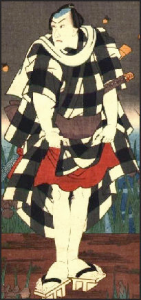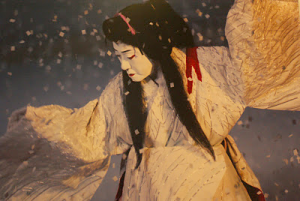11 Mar
Last month, I was fortunate to attend all four of the Japan Foundation’s Kabuki HD films at the Scotiabank Theatre.
I noted that fewer Japanese folk were in attendance than last year. Although the festival is only four years old, I do hope this isn’t an indication of a lack of interest from those who are being honoured.
The theatre was filled for each screening. We gaijin – non Japanese – were there in droves. My old friend Grace was looking forward to remembering her happy times in Japan enjoying unique Kabuki theatre. There are only a few of these spectacular theatres left there.
I talked afterwards to Joanne who is married to a Japanese and has become enamoured with the culture. She has been studying the history and enjoying the arts and crafts. We spent a fun time comparing knowledge and learning from each other. She actually makes miniatures and has made some wonderful tiny sushi items.
The atmosphere at these films was more festive than regular cinema. That is definitely part of the appeal. There were some women in exquisite kimonos and I loved studying how they moved. Having been briefed by a Japanese friend years ago on some of the etiquette and grace, I know how challenging proper movements can be.
The Zen Substitute was a dance comedy. What fun to see a moral story written for people who probably could not read. The theatre taught moral values then. This film is actually a 20th century farce rendered from the 15th century original. In this case the lessons, which are still of great value, have been adapted to suit a slightly more contemporary audience.
We see Lord Ukyo tired of his wife. He convinces her to allow him an all-night Zen meditation undisturbed. He forces his reluctant servant to replace him with a hood hiding his identity. Then, the Lord speeds to his mistress’ side for an evening of fun and frolic. Unsuspecting, he arrives home still inebriated believing his wife is naive to his evening’s merriment. The subsequent activity is amusing and the wronged get their retribution.
Murder in a Hell of Oil Originally I had understood that this film was to be performed with the Bunraku puppets mimicking the original play from 1709. Disappointingly, this was not the case. It was a 1909 reformed version using human actors.
Murder is billed as having two of the finest actors currently living in Japan. In 1992. Japan submitted it for an Oscar in the best foreign film category, alas unsuccessfully.
The setting is Osaka. Yohei son of an oil merchant is partying and dancing his life away. Another man’s wife Okichi favours him. She protects and cares for him until he becomes too excessive for her to bear. His parents are very concerned by his behaviour but by then Yohei is too embarrassed to let them help. This creates more stress on all his relationships. It promotes an extraordinary fight leading to a truly bazaar murder when Okichi refuses to lend him money to appease his debtors.
Traditionally actors in Kabuki are a generational profession. Other family members can be in the same production. In this film it is delightful to see this tradition continuing with the main actor Kataoka Nizaemon, his son Takataro, and grandson Sennosuke.
I enjoyed it very much and dutifully will remember not to squander my life away.
Heron Maiden. Terpsichore the goddess of dance must have been smiling on Tamasaburo Bando when he was born. There are no words to adequately express the beauty of the movements of this very fine artist.
The story has it that men were brawling over female actresses in the early 1600’s in Japan. The authorities thus decided to ban women from the stage. This created a new art form with some of the male performers. Onnagata (female form) are male performers who specialized in women’s roles. Some are more womanly than women.
Considered the top of this art today, Tamasaburo Bando has won many awards and performed with famous western dancers such as Rudolph Nureyev, Margot Fonteyn, and cellist Yo Yo Ma.
Heron Maiden is only half an hour long and so important that folks I met told me they had come from the suburbs to experience this classic Heron Maiden in HD. This YouTube clip will give you an idea of how magical this performance is. Donald Ritchie, a renown Japanese historian, explains the movements. See: http://bit.ly/cMRoM .
Hokaibo. Every year I forget that some Japanese have a type of humour that I am not enamoured with. Such is the case with Hokaibo. This play is very much like the English raw-humoured pantomimes. There are explicit gestures, rough brawls and lessons to be learned. This play is about the fate of a monk who loved the pleasures of the flesh too much. I do not find this form of entertainment to my liking. I left early and thus cannot report on it.
For my previous Blog on Kabuki and other theatre arts, see: http://bit.ly/yu6ZRn .



